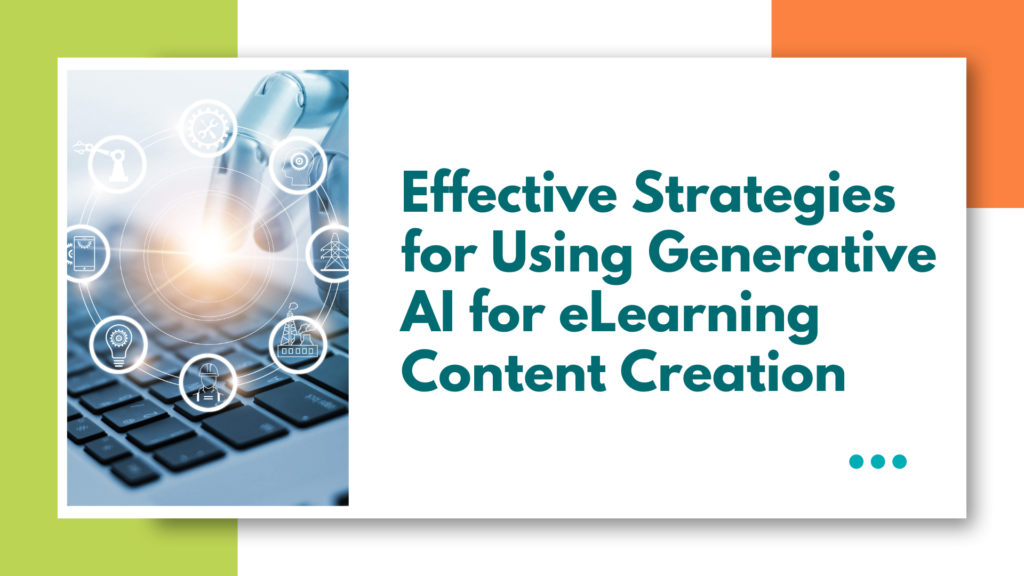Generative AI is a powerful tool that has the potential to revolutionize eLearning content creation. With its ability to automate tasks, personalize learning experiences, and generate content, generative AI is transforming the way educational materials are developed and delivered. In this article, we will explore effective strategies for using generative AI in eLearning content creation, taking advantage of its capabilities to enhance personalization, create immersive learning experiences, ensure quality and efficiency, facilitate multilingual content creation, and reduce costs.
- Personalization: One of the key benefits of generative AI in eLearning is its ability to personalize learning experiences. Adaptive learning tools with AI capabilities can analyze learner data, assess their strengths and weaknesses, and dynamically adapt the course content to fit their specific needs. By tailoring the learning experience to individual learners, generative AI promotes engagement, increases motivation, and fosters a deeper understanding of the subject matter.
- Immersive Learning: Generative AI can enhance the effectiveness of eLearning strategies, such as mobile learning (mLearning) and gamification, by making them more immersive. AI-powered virtual reality (VR) and augmented reality (AR) technologies can create interactive and realistic learning environments, enabling learners to explore concepts and apply knowledge in a hands-on and engaging manner. This immersive approach improves knowledge retention and provides a more memorable learning experience.
- Continuous Monitoring: To ensure top-notch quality, diversity, equity, and inclusion (DEI), and efficiency, it is essential to continuously monitor and evaluate the generative AI-powered eLearning content creation process. Implement performance metrics, feedback loops, and other evaluation methods to assess the effectiveness of the content and make necessary adjustments. This iterative approach enables continuous improvement and ensures that the generated content meets the desired standards.
- Automated Content Generation: Generative AI can automate the process of content generation, saving time and effort for instructional designers and educators. Large language and image AI models can be utilized to automatically generate content, such as articles, blog posts, or social media posts. These models can generate high-quality, relevant, and engaging content based on specific parameters and guidelines, freeing up human resources to focus on other critical aspects of eLearning development.
- Efficient Content Creation: By automating repetitive tasks such as formatting, proofreading, and editing, generative AI streamlines the content creation process, making it more efficient. AI-powered tools can assist in organizing and structuring the content, ensuring consistency and coherence throughout the course. This efficiency allows instructional designers and educators to allocate their time and energy towards creating more impactful and meaningful learning experiences.
- Multilingual Content Creation: Generative AI can facilitate the creation of multilingual content, breaking language barriers and reaching a wider audience. AI language models equipped with translation capabilities can automatically convert text into different languages, enabling the delivery of eLearning materials to diverse learner populations. This feature enhances accessibility, promotes inclusivity, and supports global learning initiatives.
- Cost-Effectiveness: Generative AI offers cost-effective solutions for eLearning content creation. By automating various aspects of the process, generative AI reduces the need for extensive human intervention, minimizing costs associated with manpower and resources. Additionally, the efficiency and scalability provided by generative AI contribute to significant cost reductions in the long run. This cost-effectiveness allows educational institutions and organizations to allocate their budgets towards improving other aspects of the learning experience.
Conclusion

Generative AI is transforming eLearning content creation by providing effective strategies for personalization, immersive learning, continuous monitoring, automated content generation, efficient content creation, multilingual content creation, and cost-effectiveness. By harnessing the power of generative AI, educational institutions and organizations can deliver highly tailored, engaging, and inclusive learning experiences to learners worldwide. As generative AI continues to advance, it holds great promise for the future of eLearning, shaping a more dynamic and impactful educational landscape.




